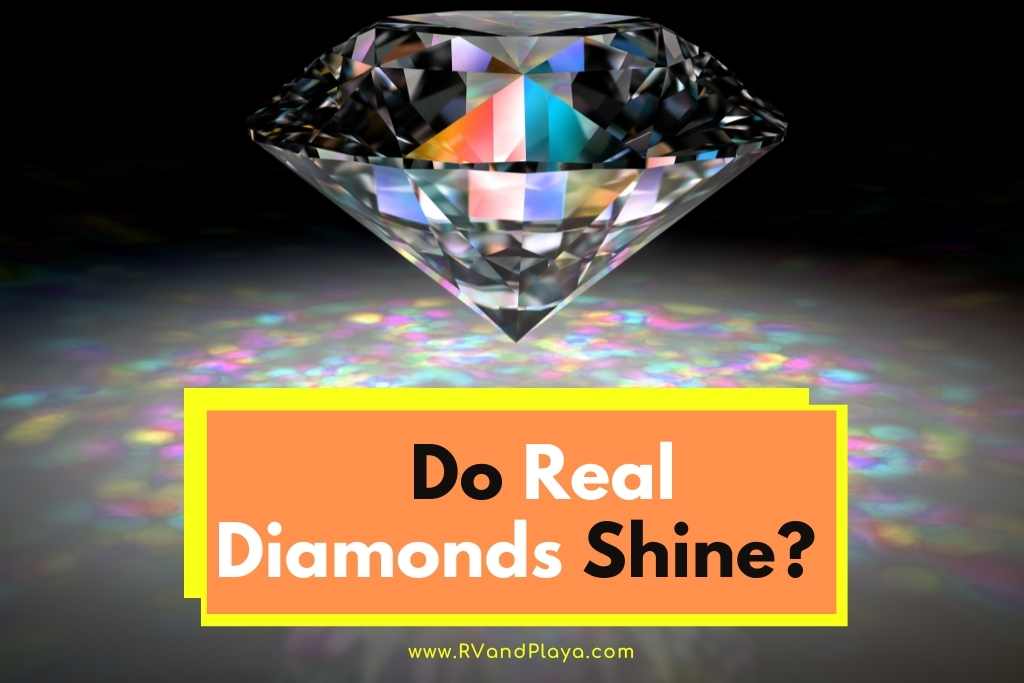The importance of diamonds in jewelry and the central role they play in the perception of wealth and luxury is indisputable. From engagement rings to the Queen’s crown to references in pop songs, diamonds are at the very heart of jewelry, and consequently luxury.
They are by far the most popular gemstones. The radiant, twinkling shine of a diamond is its hallmark feature and what makes people shell out thousands of dollars to acquire one.
But are real diamonds inherently shiny in their natural state? Or is all that radiance and allure artificial? Let’s dive deep into this!
Table of Contents
Do Real Diamonds Shine?
Yes, real diamonds do shine in their natural state but it is a much softer glow compared to the bright, eye-catching sparkle we usually associate with diamonds. Why? The reason behind this is that most of the sparkle and glimmer comes from the cutting and polishing process of the diamond, so an uncut diamond will not be as radiant as the finished product.
The reason why diamonds shine has to do with the reflection, refraction, and dispersion of light within the gem. First of all, when light rays strike the surface of the diamond some of them are directly reflected and a glow is produced.
However, the majority of the diamond’s scintillating brilliance comes from the refraction and dispersion of light happening within the diamond itself. The different flashes of rainbow colors produced when light shifts over a diamond are due to dispersion.
For optimum brilliance, the diamond has to be cut in such a way that light strikes the critical angle and is reflected internally towards the surface.
To achieve this, skilled craftsmanship and in-depth knowledge of the properties of light reflection within the structure of a diamond are necessary. So, it is no surprise that the cutting and polishing of the diamond play a major role in determining its brilliance and fire.
This also adds to the ultimate value of the diamond along with other properties such as weight, clarity, and color.
Read also >> Do Fake Diamonds Shine Rainbow? (All You Need To Know)
Read also >> Do Diamonds Shine In The Dark? (Real, Fake, VVS + More)
How Diamonds Shine
When referring to the shine of the diamond, three separate terms are used that are related to different properties of light reflection and dispersion.
The term ‘brilliance’ is most closely associated with shine and refers to how well light is reflected internally up to the surface of the diamond. It is highly dependent on the cut of the diamond.
‘Fire’ refers to the different colors that are visible as light disperses while passing through the diamond. Since white light is made up of a spectrum of different colors, when it is split up these colors are visible individually.
This phenomenon is observed not just in diamonds but when light passes through any transparent substance under the right conditions, such as a prism or even water—producing a rainbow!
‘Scintillation’ refers to the movement of light as it passes through the diamond. This produces bright sparkles and flashes rather than a continuous glow.
Scintillation is an important property of a diamond as it contributes toward that eye-catching twinkle that can be spotted even from across the room.
- Save an Average of $350* on Lab-Created Diamonds
- James Allen is the leader in online diamond sales
Real Vs Fake Diamonds
Since diamond jewelry is so popular and highly coveted, as well as expensive, it was inevitable that fake diamonds would infiltrate the market. So how exactly do you spot a fake diamond and avoid getting scammed?
If you have no prior knowledge of diamonds or gemstones at all and haven’t observed them closely before, it would be best to get the opinion of an expert on the matter.
However, if you think you can spot the differences between real and fake diamonds, and have a magnifying glass on hand, there are a few things to look out for that will give you a clue about whether the gem is genuine.
First of all, get a loupe (small magnifying glass used to observe jewelry) and look at the diamond closely, focusing on the minute details. For example, real diamonds will have some imperfections since they occur naturally whereas fake diamonds are usually flawless and perfect looking.
Real diamonds also have sharper edges as compared to fake diamonds which have softer, rounded edges.
Also, observe the metal from which the piece of jewelry is made or in which the diamond is mounted. If the metal is anything other than pure gold or platinum, it is unlikely that the diamond is real since a genuine diamond would be mounted in expensive metal.
To get a final verdict, visit a jeweler’s shop or gem expert and have the jewelry properly examined.
Ways To Spot Fake Diamonds
Here are some simple tips and tricks through which you can test whether your diamond is real or not! Keep in mind however that while these tests will give you a good idea of the authenticity of the stone, they are not definitive, and you should not rely on them completely as the results might not be accurate.
1. The Fog Test
The fog test is a pretty simple and quick test that can be performed to determine the authenticity of the diamond.
Simply blow air from your mouth onto the diamond and observe whether it fogs up or not and how long it takes for the fog to disappear.
Real diamonds fog up just a little and clear quickly whereas the condensation lasts much longer on fake diamonds.
2. Scratch Test
Since diamonds are known for being one of the hardest materials on earth, it makes sense to test for this property.
Simply take a sharp object or sandpaper and rub it against the stone. If the scratches appear on the surface, then this means that the diamond is fake.
3. The Sink or Float Test
Another straightforward test that can be used to determine whether a diamond is genuine or not is to observe whether it sinks or floats when placed in water.
Put the diamond in some water and observe its behavior. A real diamond will sink to the bottom of the container whereas a fake one would float.
4. Light Reflection
Real diamonds reflect both white light along with various colors of the rainbow due to reflection and dispersion happening when light rays strike the diamond.
To test for this, hold the diamond up in bright light and observe which colors are produced. A fake diamond will produce either white light only or a variety of colors except for white. Real ones produce both.
5. Get an Expert Opinion
The final and most conclusive way to determine for sure whether your diamond is real or not is by taking it to a gemologist or jewelry expert to take their opinion on the matter.
This will tell you for sure whether the diamond is genuine or not!
How Are Diamonds Made?
Natural diamonds are formed from carbon deposits under the earth’s crust through intense pressure and temperature conditions.
These extreme factors cause the carbon to crystallize over a matter of hundreds to billions of years.
The diamonds are then removed from the ground through a process of extraction known as diamond mining.
Diamonds can also be manufactured in labs if the right conditions are created. These lab-grown diamonds have the same chemical and physical characteristics as real diamonds and are considerably cheaper and faster to produce as well.
Lab-created diamonds have gained popularity in the last few years, with more and more people opting for them since they give the same look as real diamonds but are not as expensive.
Famous Diamonds
If you are interested in knowing more about diamonds, here is a list of the top five most popular diamonds in the world!
- Koh-i-Noor (one of the largest diamonds in the world, originally discovered in the Indian subcontinent and currently a part of the crown jewels)
- Cullinan diamond (the largest rough diamond in the world)
- Pink Star (one of the largest pink diamonds discovered till now)
- Jubilee diamond
- Hope Diamond
James Allen is the leader in online diamond sales. Their imaging technology is the same as inspecting a diamond with a jeweler's loupe. They have the largest exclusive loose diamond inventory online and fantastic prices.
They also have the nicest collection of lab created diamonds online. Save 10% off select lab grown diamonds and 25% off ring settings during limited time sale!
WHAT WE LOVE ABOUT THEM:
- No questions asked returns within 30 days of shipment. James Allen will send you a paid shipping label to return the ring.
- Lifetime Warranty
- Free International Shipping
- Free prong tightening, repolishing, rhodium plating and cleaning every 6 months
- Provide insurance appraisals
- One free resizing within 60 days of purchase
- Free ring inscriptions
- Best-in-class high quality imagery of all diamonds in stock
- 24/7 Customer Service
- Best-in-class packaging
Conclusion
To sum up, real diamonds do indeed shine by reflecting light at various angles. Natural, uncut diamonds have a softer shine and are duller as compared to diamonds that have been cut and polished.
Cutting and polishing techniques contribute a lot toward the ultimate brilliance and fire of the diamond.
The shine of a diamond is because of light reflection, refraction, and dispersion both on the surface and inside the diamond itself.
Expert cutting of a diamond plays a major role in getting light to hit that critical angle internally and reflect towards the surface to create a bright sparkle.
References
https://www.serendipitydiamonds.com/blog/bite-sized-diamond-facts-diamond-sparkle/
https://www.businessinsider.com/how-to-tell-if-a-diamond-is-fake-or-real-2015-1
https://geology.com/articles/diamonds-from-coal/
Recent Posts
Diamonds are known to sparkle and shine. But what about in the dark? Do diamonds shine in the dark? Diamonds do not shine in the dark. They don't make their own light. Diamonds can only shine when...
Do you know how to spot a fake diamond? There are several ways to spot a fake though sometimes it is quite difficult, especially with mounted stones. If you are in the market for a diamond, you...


